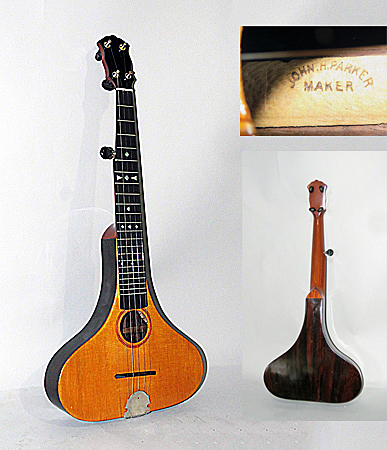
Owner: HWMC
Catalog#: 2CL-CHLT-125
Miscellaneous Lutes
'Bandola' - John Henry Parker (5-String)
New Hampshire, USA
John H. Calvert-Parker
Wood, mother-of-pearl, metal strings, metal
ca. 1922
Height: 26 in; Width: 11.25 in; Depth: 2.75 in
Strings – Lutes – Miscellaneous Lutes
Label inside: PATENTED / JAN. 22 No. 94 / JOHN. H. PARKER / MAKER / BANDOLA
This 5-string Parker ‘bandola’ has inlaid mother-of-pearl on the fingerboard, with 22 metal frets and a bone bridge at the top. It is played as a banjo or an octave mandolin. John Henry Parker, born in the United Kingdom of 1860, emigrated to Quebec in his early twenties. He was listed in the 1893 Montreal city directory as “John H. Parker, EXPERT TEACHER, and Manufacturer of the “PERFECTION’ BANJOS, Bandolas, Guitars, and Mandolins, 131 Bleury.”
In 1894, Parker received a patent for his uniquely shaped mandolins and guitars. The design improved access to the upper frets of the instruments by cutting away the upper bouts on both sides of the neck. While reducing the size of the bodies, he claimed to improve the tone of the higher registers, and he provided a full two-octave fretboard. He also patented a one-piece metal tailpiece that anchored and covered the sharp ends and windings of the loop-end strings.
The Parker family moved again to Portland, Maine, where John Henry set up The Bandola Co. on Congress Street downtown. The 1908 and 1909 Portland city directories show “Bandola Company, 536a Congress Street John H. Calvert-Parker, music teacher.” Parker later moved to Keene, New Hampshire, and set up The Bandola Co. in the old Ralston House Tavern, producing a line of mandolins, guitars and banjos. He sold them to dealers and his students at The Parker Banjo, Mandolin and Guitar School.
Parker received another patent in 1922 for a banjo with a wooden soundboard located below the skin banjo head, creating an internal sound chamber. The skin head was connected to the soundboard by means of a secondary bridge, and the tone could be adjusted by means of a wooden slider wedged between the soundboard and the dowel stick. Parker claimed the soundboard increased the sound and improved the tone of his banjos.
Resource: https://www.fretboardjournal.com/features/tale-two-luthiers-john-henry-parker-and-joel-eckhaus/
